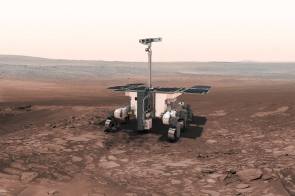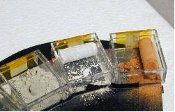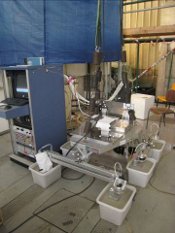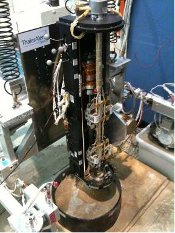ExoMars drill tests
 |
| The ExoMars rover. Credit: ESA |
The ExoMars Drill, situated on the European ExoMars Rover, is devised to acquire soil samples down to a maximum depth of 2 metres, in a variety of soil types.
A number of breadboarding activities and tests have taken place over the past 2 years, including a series of tests, in simulated Martian environments, which have been completed in recent months. These activities are summarised below.
A full breadboard unit for the Drill and its Positioner, including some of the electronic elements, has been built and tested. The breadboard has undergone a number of functional verification tests in the past 2 years, both at subsystem level (for example, testing of tool sample acquisition capability, automatic handling of tool and extension rods, upper and lower clamps, positioner elements) and at system level, the latter including multiple drilling in 2-metre-deep columns of materials with different mineralogy characteristics. Reference materials have been selected and used to evaluate and characterize the performance of the system. In addition, tests have been performed under conditions that simulate the Martian environment, in particular, reproducing the range of temperatures and pressures in which the Drill will operate.
 |
 Above: Core samples acquired with Drill tool. Credit: SELEX Galileo |
| Above: The laboratory setup (Drill + soil sample + thermovacuum chamber) used for testing the Drill in a simulated Mars environment. Credit: SELEX Galileo. | |
Furthermore, the capability of the Drill to operate when integrated on the Rover has been successfully tested in recent months. The Drill breadboard has been installed on one of the two existing chassis/locomotion breadboards, modified to simulate the mass and the center of gravity of the intended design, and the system has been off-loaded through a spring device to simulate the weight in Martian gravity.
 |
 Above: The Drill breadboard installed on the ExoMars Rover chassis and LSS breadboard. Credit: ThalesAleniaSpace-I |
| Above: The ExoMars Rover chassis and locomotion subsystem (LSS) breadboard off-loaded, to simulate Martian gravity. Credit: ThalesAleniaSpace-I. | |
The Drill breadboard included both the complete Drill unit, with extension rods and rod magazine, and the Positioner (translation and rotation joint). In addition to the package of sensors already present in the Drill unit, an optical tracking system, with cameras and targets mounted in various key locations, and a force sensor at the interface between the Rover and the Drill, have been used to evaluate the dynamic behaviour during drilling.
 |
 |
| The Drill breadboard attached to the ExoMars Rover chassis and LSS breadboard. Credit: SELEX Galileo & ThalesAleniaSpace-I | |
A series of drilling operations down to 2 metres have been performed in different configurations in a test environment at Thales Alenia Space, Turin, Italy. The soil stratigraphy conformed to the reference definition of materials that was used also in the previous breadboard validation tests at Selex Galileo in Milan, Italy. The scenarios included drilling with the Rover chassis on solid ground and on sand, first without wheels (using pads in their place) and finally on wheels.
A further test campaign with new materials, which have been identified by a dedicated Working Group as representative of possible subsurface scenarios on Mars, is planned in the summer of 2010. This campaign will include tests of drilling and sample acquisition in frozen soil containing ice and organic compounds. The tests are devised to verify the capability of the Drill to acquire the sample without compromising possible organic/volatiles fraction contents.
For further details, please contact:
Pietro Baglioni, ExoMars Rover Manager (Acting)
Email: Pietro Baglioni esa.int
esa.int
